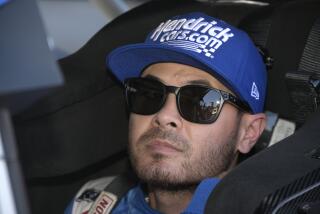Expanded Role for Video Games
- Share via
DAYTONA BEACH, Fla. — Elliott Sadler has circled Daytona International Speedway thousands of times this week -- most of the them while sitting in his motor home.
He logged laps long before qualifying, right after practice and late into the night. He sharpened his drafting skills, worked the high side of the track and tried to find new ways to pass.
He’s not alone, either.
A growing number of drivers -- including Dale Earnhardt Jr., Ryan Newman and the rest of NASCAR’s MTV generation -- use video games to help them hone their skills at various tracks. It has become an integral part of their race preparation.
“You’d be amazed what you learn from playing these games,” Sadler said. “You can pick up little tidbits here and there. When you get to a track, you already feel like you’ve been there a week because you’ve been playing the video games.”
Sadler has a motor home that has been customized for video games. It has two 42-inch plasma screen televisions with two Xboxes -- one in the front and another in the back. As many as eight people can play games at the same time.
“His motor coach is legendary,” said Tom Goedde, a senior product manager at EA Sports in charge of marketing for NASCAR games.
Goedde has worked closely with NASCAR on racing games since 1997. But in the last few years, with drastic improvements in computer graphics and technology, the games have become increasingly realistic. So much so that drivers have started to rely on them as training tools.
“It especially helps if you’re going to a track for the first time,” 2002 NASCAR champion Tony Stewart said. “You see it on TV, but you don’t have any idea what coming up that hill at Watkins Glen looks like.”
The video games offer the most help on road course, like Watkins Glen and Sonoma. That’s where drivers use visual cues -- like a sign or a tree -- as reference points for breaking, accelerating, turning, pitting, lane positioning or passing.
“There are some flaws, but for the most part the tracks are real similar,” said Kyle Busch, one of two rookies in today’s Daytona 500.
Busch raced the track several times before he ever turned a lap in preparation for his first Daytona. He said he learned a lot from it, too.
“I started from the back and realized how quickly you can get to the front,” said Busch, who will start 19th Sunday. “It’s not the real deal, but it’s real close.”
Goedde’s work has a lot to do with that.
His company’s video game, “NASCAR 2005: Chase for the Cup,” is the main one used by many drivers. EA Sports also just released “NASCAR SimRacing,” a personal computer game that is even more realistic and intended to be as close as possible to actually being behind the wheel.
EA Sports sent a survey team to each track and recorded pages and pages of detailed records. They took thousands of photographs and secured blueprints from grandstands and infield buildings.
“We spend a tremendous amount of time getting it right,” Goedde said. “We know exactly where each cone is placed at every track.”
Getting feedback from drivers was an even more important aspect to enhancing the video games.
Newman spent countless hours testing the “Chase for the Cup” for EA Sports. Earnhardt, who holds a weekly video game session with his buddies, and Martin Truex Jr. did the same.
“All the survey information in the world won’t tell us that coming out of turn four at Daytona there’s a bump that about takes your kidneys out every time you come across it,” Goedde said. “Junior can tell us all about that.”
So could seven-time NASCAR champion Richard Petty. But then again, the King didn’t grow up playing Atari and Nintendo and might not even be able to use a controller.
“We didn’t even have computers and all that stuff,” Petty said. “Even if we had, we wouldn’t have had time to mess with them because we were always working on our race cars. It’s just a different generation. It’s just a trend of the times.”
One that Sadler hopes will help him today -- and for the rest of the season.
“It’s really neat how far this thing has come,” said Sadler, who estimated he has raced Daytona a “few hundred times” this week. “There’s just a ton of stuff you can pick up from it.”
More to Read
Go beyond the scoreboard
Get the latest on L.A.'s teams in the daily Sports Report newsletter.
You may occasionally receive promotional content from the Los Angeles Times.










